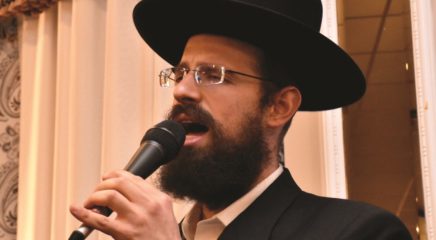Yisroel Werdyger once again combines his sweet-strong voice with a warm, heimishe style
I
n his recently released fifth album, Du Voint a Yid, Yisroel Werdyger once again combines his sweet-strong voice with a warm, heimishe style, bringing listeners a new set of danceable wedding material and hartzige kumzitz songs, all original compositions with a fresh feel.
The CD was produced and arranged by Sruly Werdyger’s longtime trusted friend Shua Fried. “Shua and I go back to our yeshivah days in Yerushalayim,” he says. “I’m an American, and he comes from a real Yerushalmi home. We met when Yeshiva Sfas Emes, where we were both learning, arranged a Shabbos hisvaadus, and I wound up sitting next to him on the bus. We got to talking, and since he was musically inclined, our conversation went straight to music. That trip was the start of our close relationship, and we later became chavrusas. After we both married, Shua went on to study music, and I went on to sing. When I felt ready to put out my first album, it was only natural that Shua was the person I was going to work with, and baruch Hashem we’re on to our fifth album together.”
The first track, entitled “Chap a Tentzel,” is an innovative collaboration between Werdyger and Bnei Brak-based Vizhnitz wedding musician Meir Adler. Adler sent Werdyger the melody and lyrics —“Zug nisht as se past nisht, zug nisht as di kenst nisht, heib ah fissel chap ah tentzel likras chussen kalleh” [“Don’t say it’s not your thing, don’t say you can’t dance, just lift your feet and dance for the chassan and kallah”] — and the singer added the “Oy, yoy yoy yoy yoy” bridge of the song, a reflection of his own musical taste. “I guess you could say that it’s the first time I’m using a composition of my own,” he reflects. It’s an upbeat, whimsical interlude to a song that is sure to reach its goal — to get everyone up and dancing.
Two other contributing composers, Rabbi Hillel Paley and Rabbi Pinchas Breuer, are both maggidei shiur and mashpiim, Rabbi Paley in Beit Shemesh and Rabbi Breurer in the Belzer yeshivah in Ashdod — and although Sruly Werdyger has worked with Rabbi Paley for years, he has yet to meet either one in person. The yeshivah world is still singing Rabbi Paley’s “Mesikus Hatorah,” which Werdyger released in 2012. “It was obvious that Shua Fried would reach out to Rabbi Paley when we were acquiring songs,” Werdyger says. “Rabbi Paley’s contribution to this album, ‘Omru Yisroel’ is a meaningful, uplifting song full of encouragement.”
Rabbi Breuer’s best-known compositions, “Ribon Haolamim Yadati” and “Hishbati Eschem” are world famous, and the new album features three more of his songs — “Moshcheini,” “Ad Heina,” and “Hashem Li” — each of which, says Werdyger, “is a gem in its own right.”
The next generation of Werdygers is joining the elders at the studio too. On Du Voint a Yid, Sruly brings sons Avrumi and Yoni along as child soloists. To him, it’s the most natural thing in the world. “Singing is a central part of family time at the Werdyger home,” he says. “On Shabbos we sing together, and my children wanted to be part of the album as well.”
The title track, “Du Voint a Yid” [ “A Jew Lives Here”] puts a powerful and intriguing concept into song. Composer Hershy Rottenberg says that the song came to him as he told his children Rav Moshe Leib of Sassov’s explanation of the first Pesach night, how “on the night of Yetzias Mitzrayim, Hashem jumped over each Jewish rooftop, singing out ‘Du voint a Yid.’ I told them that if we keep our home sweet and holy and full of light, Hashem is dancing on top of our home too.”
(Originally featured in Mishpacha, Issue 789)




